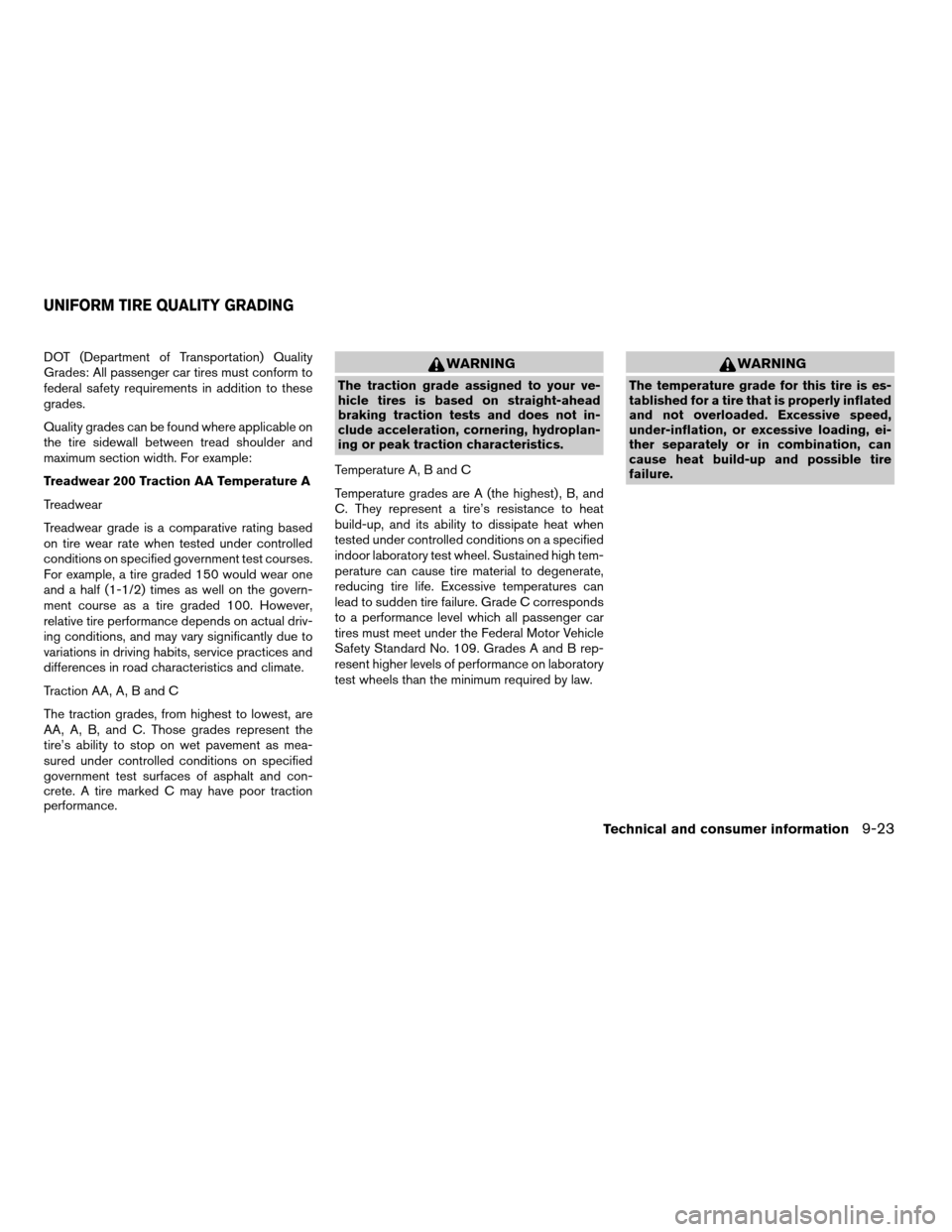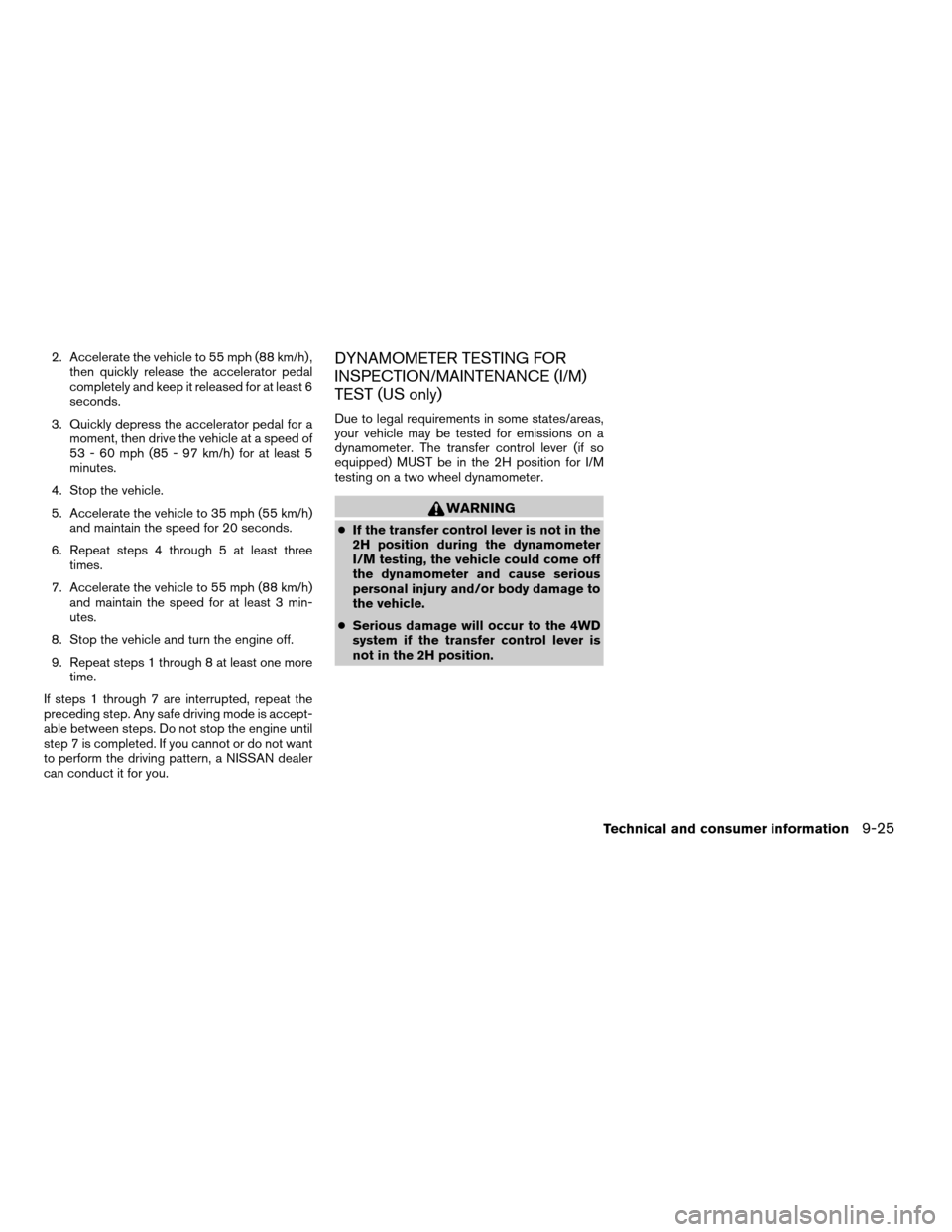2003 NISSAN FRONTIER wheel
[x] Cancel search: wheelPage 252 of 272

Trailer towing tips
In order to gain skill and an understanding of the
vehicle’s behavior, you should practice turning,
stopping and backing up in an area which is free
from traffic. Steering stability and braking perfor-
mance will be somewhat different than under
normal driving conditions.
cAlways secure items in the trailer to prevent
load shift while driving.
cAvoid abrupt starts, acceleration or stops.
cAvoid sharp turns or lane changes.
cAlways drive your vehicle at a moderate speed.
cAlways block the wheels on both vehicle and
trailer when parking. Parking on a slope is not
recommended; however, if you must do so,
and if your vehicle is equipped with an auto-
matic transmission, first block the wheels and
apply the parking brake, and then move the
transmission shift selector lever into the P
(Park) position. If you move the shift selector
lever to the P (Park) position before blocking
the wheels and applying the parking brake,
transmission damage could occur.
cWhen going down a hill, shift into a lower gear
and use the engine braking effect. When go-
ing up a long grade, downshift the transmis-
sion to a lower gear and reduce speed toreduce chances of engine overloading and/or
overheating. However, for long steep grades,
do not stay in 1st or 2nd gear when driving
above 35 MPH (56 km/h) .
cIf the engine coolant rises to an extremely high
temperature when the air conditioner system
is on, turn off the air conditioner. Coolant heat
can be additionally vented by opening the win-
dows, switching the fan control to high and
setting the temperature control to the HOT
position.
cTrailer towing requires more fuel than normal
circumstances.
cAvoid towing a trailer for your vehicle’s first
500 miles (805 km) .
cHave your vehicle serviced more often than at
intervals specified in the recommended Main-
tenance Schedule in the “NISSAN Service
and Maintenance Guide”.
cWhen making a turn, your trailer wheels will be
closer to the inside of the turn than your vehicle
wheels. To compensate for this, make a larger
than normal turning radius during the turn.
cCrosswinds and rough roads will adversely
affect vehicle/trailer handling, possibly caus-
ing vehicle sway. When being passed by
larger vehicles, be prepared for possible
changes in crosswinds that could affect ve-hicle handling. If swaying does occur, firmly
grip the steering wheel, steer straight ahead,
and immediately (but gradually) reduce vehicle
speed. This combination will help stabilize the
vehicle. Never increase speed.
cBe careful when passing other vehicles. Pass-
ing while towing a trailer requires considerably
more distance than normal passing. Remem-
ber, the length of the trailer must also pass the
other vehicle before you can safely change
lanes.
cTo maintain engine braking efficiency and
electrical charging performance, do not use
5th gear (manual transmission) or overdrive
(automatic transmission) .
cAvoid holding the brake pedal down too long
or too frequently. This could cause the brakes
to overheat, resulting in reduced braking effi-
ciency.
When towing a trailer, transmission
oil/fluid should be changed more fre-
quently. For additional information, see the
“Maintenance and do-it-yourself” section
earlier in this manual.
9-22Technical and consumer information
ZREVIEW COPY:Ð2003 Truck/Frontier(d22)
Owners Manual(owners)ÐUSA English(nna)
01/15/03Ðarosenma
X
Page 253 of 272

DOT (Department of Transportation) Quality
Grades: All passenger car tires must conform to
federal safety requirements in addition to these
grades.
Quality grades can be found where applicable on
the tire sidewall between tread shoulder and
maximum section width. For example:
Treadwear 200 Traction AA Temperature A
Treadwear
Treadwear grade is a comparative rating based
on tire wear rate when tested under controlled
conditions on specified government test courses.
For example, a tire graded 150 would wear one
and a half (1-1/2) times as well on the govern-
ment course as a tire graded 100. However,
relative tire performance depends on actual driv-
ing conditions, and may vary significantly due to
variations in driving habits, service practices and
differences in road characteristics and climate.
Traction AA, A, B and C
The traction grades, from highest to lowest, are
AA, A, B, and C. Those grades represent the
tire’s ability to stop on wet pavement as mea-
sured under controlled conditions on specified
government test surfaces of asphalt and con-
crete. A tire marked C may have poor traction
performance.WARNING
The traction grade assigned to your ve-
hicle tires is based on straight-ahead
braking traction tests and does not in-
clude acceleration, cornering, hydroplan-
ing or peak traction characteristics.
Temperature A, B and C
Temperature grades are A (the highest) , B, and
C. They represent a tire’s resistance to heat
build-up, and its ability to dissipate heat when
tested under controlled conditions on a specified
indoor laboratory test wheel. Sustained high tem-
perature can cause tire material to degenerate,
reducing tire life. Excessive temperatures can
lead to sudden tire failure. Grade C corresponds
to a performance level which all passenger car
tires must meet under the Federal Motor Vehicle
Safety Standard No. 109. Grades A and B rep-
resent higher levels of performance on laboratory
test wheels than the minimum required by law.
WARNING
The temperature grade for this tire is es-
tablished for a tire that is properly inflated
and not overloaded. Excessive speed,
under-inflation, or excessive loading, ei-
ther separately or in combination, can
cause heat build-up and possible tire
failure.
UNIFORM TIRE QUALITY GRADING
Technical and consumer information9-23
ZREVIEW COPY:Ð2003 Truck/Frontier(d22)
Owners Manual(owners)ÐUSA English(nna)
01/15/03Ðarosenma
X
Page 255 of 272

2. Accelerate the vehicle to 55 mph (88 km/h) ,
then quickly release the accelerator pedal
completely and keep it released for at least 6
seconds.
3. Quickly depress the accelerator pedal for a
moment, then drive the vehicle at a speed of
53 - 60 mph (85 - 97 km/h) for at least 5
minutes.
4. Stop the vehicle.
5. Accelerate the vehicle to 35 mph (55 km/h)
and maintain the speed for 20 seconds.
6. Repeat steps 4 through 5 at least three
times.
7. Accelerate the vehicle to 55 mph (88 km/h)
and maintain the speed for at least 3 min-
utes.
8. Stop the vehicle and turn the engine off.
9. Repeat steps 1 through 8 at least one more
time.
If steps 1 through 7 are interrupted, repeat the
preceding step. Any safe driving mode is accept-
able between steps. Do not stop the engine until
step 7 is completed. If you cannot or do not want
to perform the driving pattern, a NISSAN dealer
can conduct it for you.DYNAMOMETER TESTING FOR
INSPECTION/MAINTENANCE (I/M)
TEST (US only)
Due to legal requirements in some states/areas,
your vehicle may be tested for emissions on a
dynamometer. The transfer control lever (if so
equipped) MUST be in the 2H position for I/M
testing on a two wheel dynamometer.
WARNING
cIf the transfer control lever is not in the
2H position during the dynamometer
I/M testing, the vehicle could come off
the dynamometer and cause serious
personal injury and/or body damage to
the vehicle.
cSerious damage will occur to the 4WD
system if the transfer control lever is
not in the 2H position.
Technical and consumer information9-25
ZREVIEW COPY:Ð2003 Truck/Frontier(d22)
Owners Manual(owners)ÐUSA English(nna)
01/15/03Ðarosenma
X
Page 259 of 272

10 Index
A
Air bag
Passenger supplemental air bag
ON/OFF switch and light..........1-15
Air bag (See supplemental restraint
system)......................1-6
Air bag warning light...........1-17, 2-12
Air cleaner housing filter............8-23
Air conditioner
Air conditioner operation...........4-5
Air conditioner service............4-9
Air conditioner specification label.....9-12
Air conditioner system refrigerant and
lubrication recommendations........9-6
Heater and air conditioner controls.....4-2
Servicing air conditioner...........4-9
Air flow charts..................4-6
Alarm system
(See vehicle security system).........2-15
Anchor point locations.............1-40
Antenna.....................4-28
Anti-lock brake system (ABS).........5-27
Anti-lock brake warning light..........2-10
Audible reminders................2-15
Audio system..................4-10
Compact disc (CD) player.........4-15
FM-AM radio with compact disc (CD)
changer...................4-16
FM-AM radio with compact disc (CD)
player....................4-12Radio....................4-10
Steering wheel audio control switch. . . .4-28
Auto-lock free-running hubs..........5-22
Automatic
Automatic power window switch.....2-29
Automatic transmission fluid (ATF). . . .8-14
Driving with automatic transmission. . . .5-10
Transmission selector lever lock
release....................5-14
B
Battery......................8-18
Charge warning light............2-11
Battery replacement
(See remote keyless entry system).......3-7
Before starting the engine............5-9
Belts (See drive belts).............8-20
Brake
Anti-lock brake system (ABS).......5-27
Brake booster................8-28
Brake fluid..................8-16
Brake light (See stop light).........8-34
Brake pedal.................8-27
Brake system................5-26
Brake warning light.............2-10
Brake wear indicators........2-15, 8-28
Parking brake check............8-27
Parking brake operation..........5-18
Self-adjusting brakes............8-28
Break-in schedule................5-20Bulb check/instrument panel..........2-9
Bulb replacement................8-34
C
Capacities and recommended
fuel/lubricants...................9-2
Car phone or CB radio.............4-29
Cargo lamp switch...............2-23
Cargo (See vehicle loading information) . . .9-13
CD player (See audio system).........4-15
Check engine indicator light
(See malfunction indicator light)........2-13
Child restraint with top tether
strap.......................1-40
Child restraints..........1-22, 1-29, 1-38
Precautions on child restraints.......1-29
Child safety rear door lock............3-4
Chimes, audible reminders...........2-15
Cleaning exterior and interior..........7-2
Clock...................4-13, 4-18
Clutch
Clutch fluid.................8-17
Cold weather driving..............5-30
Compact disc (CD) player...........4-15
Controls
Audio controls (steering wheel)......4-28
Heater and air conditioner controls.....4-2
Coolant
Capacities and recommended
fuel/lubricants.................9-2
ZREVIEW COPY:Ð2003 Truck/Frontier(d22)
Owners Manual(owners)ÐUSA English(nna)
01/15/03Ðarosenma
X
Page 262 of 272

O
Octane rating (See fuel octane rating).....9-4
Odometer.....................2-3
Oil
Capacities and recommended
fuel/lubricants.................9-2
Changing engine oil............8-11
Changing engine oil filter..........8-13
Checking engine oil level..........8-10
Engine oil..................8-10
Engine oil and oil filter
recommendation...............9-5
Engine oil viscosity..............9-5
Outside mirror control..........3-14, 3-15
Outside mirrors.................3-14
Overdrive switch.........5-14, 5-15, 5-16
Overheat
If your vehicle overheats..........6-11
Owner’s manual order form..........9-26
Owner’s manual/service manual order
information....................9-26
P
Parking
Parking brake check............8-27
Parking brake operation..........5-18
Parking/parking on hills...........5-25
Passenger supplemental air bag ON/OFF
switch and light.................1-15
Power
Power door locks...............3-3
Power outlet.................2-24Power steering fluid.............8-15
Power steering system...........5-26
Power windows...............2-28
Rear power windows............2-29
Precautions
Maintenance precautions..........8-5
On-pavement and off-road driving
precautions..................5-4
Precautions on child restraints.......1-29
Precautions on seat belt usage......1-19
Precautions on supplemental restraint
system.....................1-6
Precautions when starting and driving . . .5-2
Push starting..................6-11
R
Radio
Car phone or CB radio...........4-29
FM-AM radio with compact disc (CD)
changer...................4-16
FM-AM radio with compact disc (CD)
player....................4-12
Steering wheel audio control switch. . . .4-28
Readiness for inspection maintenance (I/M)
test........................9-24
Rear power windows..............2-29
Rear sliding window..............2-30
Rear window defogger switch.........2-19
Refrigerant recommendation..........9-6
Registering your vehicle in another
country......................9-10
Remote keyless entry system..........3-4
Reporting safety defects (US only)......9-24
Roof rack (see luggage rack)..........3-9S
Safety
Child safety rear door lock..........3-4
Reporting safety defects (US only). . . .9-24
Seat
Jump seat...................1-5
Seat adjustment
Front manual seat adjustment........1-2
Seat belt
Precautions on seat belt usage......1-19
Seat belt extenders.............1-28
Seat belt maintenance...........1-28
Seat belts..................1-19
Shoulder belt height adjustment......1-25
Three-point type with retractor.......1-23
Two-point type without retractor......1-26
Two-point type without retractor
(rear center lap belt)............1-26
Seat belt warning light.............2-12
Seats
Adjustment..................1-2
Front seats..................1-2
Manual front seat adjustment........1-2
Separate seats...............8-41
Self-adjusting brakes..............8-28
Service manual order form...........9-26
Servicing air conditioner.............4-9
Shift lock release................5-14
Shifting
Automatic transmission.......5-11, 5-12
Manual transmission............5-17
Shoulder belt height adjustment........1-25
Spark plug replacement............8-21
Speedometer...................2-3
10-4
ZREVIEW COPY:Ð2003 Truck/Frontier(d22)
Owners Manual(owners)ÐUSA English(nna)
01/15/03Ðarosenma
X
Page 263 of 272

Spotlights (See map light)...........2-32
SRS warning label...............1-17
Starting
Before starting the engine..........5-9
Jump starting.................6-9
Precautions when starting and driving . . .5-2
Push starting................6-11
Starting the engine..............5-9
Steering
Power steering fluid.............8-15
Power steering system...........5-26
Tilting steering wheel............3-13
Steering wheel audio control switch......4-28
Step rail.....................3-11
Stop light....................8-34
Storage.....................2-25
Supplemental restraint system
Precautions on supplemental restraint
system.....................1-6
Supplemental restraint system
(Supplemental air bag system).........1-6
Switch
Automatic power window switch.....2-29
Front fog light switch............2-22
Hazard warning flasher switch.......2-22
Headlight and turn signal switch......2-20
Ignition switch................5-7
Overdrive switch.......5-14, 5-15, 5-16
Passenger supplemental
air bag ON/OFF switch and light.....1-15
Rear window defogger switch.......2-19
Windshield wiper and washer switch . . .2-18T
Tachometer....................2-5
Tailgate latch..................3-15
Three-way catalyst................5-2
Tie down hooks.................3-17
Tilting steering wheel..............3-13
Tire
Flat tire....................6-2
Spare tire................6-4, 8-41
Tire chains..................8-38
Tire placard.................9-12
Tire pressure................8-37
Tire rotation.................8-39
Tires of 4-wheel drive............8-41
Types of tires................8-37
Uniform tire quality grading.........9-23
Wheels and tires..............8-37
Wheel/tire size................9-8
Towing
2-wheel drive models............6-13
4-wheel drive models............6-13
Flat towing..................6-15
Tow truck towing..............6-12
Towing load/specification chart......9-20
Trailer towing................9-18
Transfer case..................5-21
Transmission
Automatic transmission fluid (ATF). . . .8-14
Driving with automatic transmission. . . .5-10
Driving with manual transmission.....5-16
Selector lever lock release.........5-14
Travel (See registering your vehicle
in another country)...............9-10
Truck - camper loading.............9-15Turn signal switch (See headlight and
turn signal switch)............2-20, 2-21
U
Uniform tire quality grading...........9-23
V
Vanity mirror...................3-13
Vehicle dimensions and weights........9-9
Vehicle dynamic control (VDC) system. . . .5-28
Vehicle identification..............9-10
Vehicle identification number (VIN)
(Chassis number)................9-10
Vehicle identification number (VIN) plate . . .9-10
Vehicle loading information...........9-13
Vehicle recovery.................6-14
Vehicle security system.............2-15
Ventilators.....................4-2
W
Warning
Air bag warning light.........1-17, 2-12
Anti-lock brake warning light........2-10
Brake warning light.............2-10
Door open warning light..........2-11
Hazard warning flasher switch.......2-22
Low fuel warning light...........2-11
Low tire pressure warning light......2-11
Seat belt warning light...........2-11
Vehicle security system...........2-15
10-5
ZREVIEW COPY:Ð2003 Truck/Frontier(d22)
Owners Manual(owners)ÐUSA English(nna)
01/15/03Ðarosenma
X
Page 264 of 272

Warning labels (for SRS)..........1-17
Warning/indicator lights and audible
reminders...................2-9
Weights (See dimensions and weights). . . .9-9
Wheels and tires................8-37
Wheel/tire size..................9-8When traveling or registering your vehicle
in another country................9-10
Window washer fluid..............8-17
Windows
Locking passengers’ windows.......2-29
Manual windows..............2-30
Power windows...............2-28Rear power windows............2-29
Rear sliding window............2-30
Windshield wiper and washer switch.....2-18
Wiper
Windshield wiper and washer switch . . .2-18
Wiper blades................8-26
10-6
ZREVIEW COPY:Ð2003 Truck/Frontier(d22)
Owners Manual(owners)ÐUSA English(nna)
01/15/03Ðarosenma
X